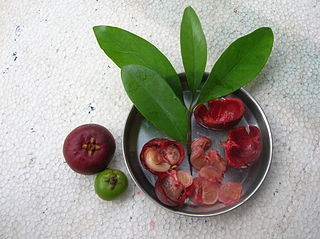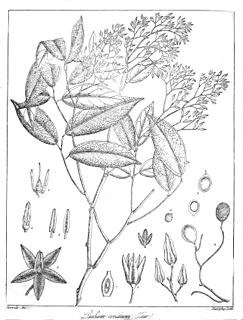
Tamarind is a leguminous tree bearing edible fruit that is indigenous to tropical Africa. The genus Tamarindus is monotypic, meaning that it contains only this species. It belongs to the family Fabaceae.

Mangosteen, also known as the purple mangosteen, is a tropical evergreen tree with edible fruit native to tropical lands surrounding the Indian Ocean. Its origin is uncertain due to widespread prehistoric cultivation. It grows mainly in Southeast Asia, southwest India and other tropical areas such as Colombia, Puerto Rico and Florida, where the tree has been introduced. The tree grows from 6 to 25 metres tall. The fruit of the mangosteen is sweet and tangy, juicy, somewhat fibrous, with fluid-filled vesicles, with an inedible, deep reddish-purple colored rind (exocarp) when ripe. In each fruit, the fragrant edible flesh that surrounds each seed is botanically endocarp, i.e., the inner layer of the ovary. The seeds are of similar size and shape to almonds.

Garcinia is a genus of flowering plants in the family Clusiaceae native to Asia, America, Australia, tropical and southern Africa, and Polynesia. The number of species is disputed; the Kew Gardens recognise up to 400. Commonly, the plants in this genus are called saptrees, mangosteens, garcinias, or monkey fruit.

Garcinia gummi-gutta is a tropical species of Garcinia native to South Asia and Southeast Asia. Common names include Garcinia cambogia, as well as brindle berry, and Malabar tamarind. The fruit looks like a small pumpkin and is green to pale yellow in color.
Kranji is a suburb in northwestern Singapore, bounded by Sungei Kadut to the north, Turf Club to the east, as well as Lim Chu Kang and the Western Water Catchment to the west.

Dialium indum, the tamarind-plum, is a tall, tropical, fruit-bearing tree. It belongs to the family Fabaceae, and has small, typically grape-sized edible fruits with brown hard inedible shells. No reports of cultivation exist, information on propagation is limited.

Dialium is a genus of flowering plants in the family Fabaceae, subfamily Dialioideae. Velvet tamarind is a common name for several species.

Dialium cochinchinense, the velvet tamarind, is a species of flowering plant in the family Fabaceae. It is native to Ghana, Sri Lanka, Cambodia, Laos, Malaysia, Myanmar, Nigeria, Thailand, Vietnam and many west African countries. It is threatened by habitat loss.

Garcinia dulcis is a tropical fruit tree native to the Philippines, Java, Lesser Sunda Islands, eastern Indonesia, and Papua New Guinea. It was domesticated early and spread inland into mainland Asia. It is commonly known as mundu or munu in Indonesia and Malaysia, baniti or taklang-anak in the Philippines, and maphuut or ma phut in Thailand.
Malaccensis may refer to:

Garcinia atroviridis, known as asam gelugur, asam gelugo, or asam keping is a large rainforest tree native to Peninsular Malaysia. This species grows wild throughout Peninsular Malaysia but is also widely cultivated, especially in the northern states, owing to its economic and medicinal value. Garcinia atroviridis is a large perennial plant commonly found in evergreen forests in the southern region of Thailand and Malaysia.
Velvet tamarind is a common name for several trees in the genus Dialium and may refer to:

Garcinia indica, a plant in the mangosteen family (Clusiaceae), commonly known as kokum, is a fruit-bearing tree that has culinary, pharmaceutical, and industrial uses.
Cordata, a Latin adjective meaning heart-shaped, may refer to:

Dialium guineense, the velvet tamarind, is a tall, tropical, fruit-bearing tree in the flowering plant family Fabaceae. It has small, typically grape-sized, edible fruits with brown, hard, inedible shells.

Dialium ovoideum is a tropical species of plant in the family Fabaceae. It is endemic to Sri Lanka. The Sinhala name ගල් සියඹලා means "pebble tamarind". The Tamil name பட்டு புளியம் பழம் means "silky tamarind" which is named after the silky texture of the shell of the fruit..

Garcinia warrenii, a is a fruit-bearing tree, up to 15 metres in height, of the mangosteen family (Clusiaceae), commonly known as native mangosteen or Warren's mangosteen. It is found in the tropical rainforests of northern and north-eastern Australia and New Guinea. The genus Garcinia, belonging to the family Clusiaceae, includes about 200 species found in the Old World tropics, mostly in Asia and Africa. Garcinia warrenii is indigenous to New Guinea, the Torres Strait Islands, northeastern Queensland from Cape York Peninsula south to Babinda, and a small, isolated population on Melville Island in the Northern Territory, Australia.

Xylosandrus crassiusculus, known generally as the Asian ambrosia beetle or granulate ambrosia beetle, is a species of tropical bark beetle in the family Curculionidae. It is native to Asia and has spread to Africa, Europe, Australasia and the Americas. The adult beetle is reddish-brown and some 2 to 3 mm long.
Garcinia nitida, also known as kandis hutan, is a species of flowering plant, a dioecious understorey fruit tree in the mangosteen family, that is native to Southeast Asia.












